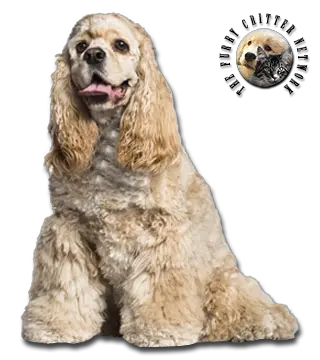Breed Standard
Head: Finely chiseled. Rounded skull. Clearly pronounced brow bones. Pronounced stop. Broad, high muzzle. Black or brown nose, depending on coat color.
Ears: Long, thin, well-feathered.
Eyes: Slightly almond-shaped, brown, as dark as possible, with an irresistible pleading expression.
Body: Short, compact. Fairly long, muscular neck without dewlap. High, broad chest. Well-sprung ribs. Strong back. Broad croup
Tail: Set on and carried level with the topline or slightly higher. Docked. Wagging in action.
Hair: Short and fine on the head. Medium in length on the body. Ears, chest, abdomen, and legs well-feathered. Hair is silky, flat, or slightly wavy. Undercoat. Coat: Solid black. Black with tan tips. A small amount of white on the chest and/or throat is allowed. Any solid color other than black. Parti-color: two or more well-broken, well-distributed colors, one of which must be white. Roans are classified as parti-colors. Tan markings range from the lightest cream to the darkest red and should cover no more than 10% of the coat. Tan markings above each eye, on the sides of the muzzle and cheeks, on the underside of the ears, on all feet and/or legs, on the chest, and under the tail.
Size: Dog: 36 to 39 cm (14-15.5 in). Bitch: 34 to 36 cm (13.5-14 in).
Weight: 10 to 13 kg (22-28 lb).
History
According to historical records, the first spaniel was brought to North America aboard the Mayflower which sailed from Plymouth, England and landed in New England in 1620. The first American Cocker Spaniel Spaniel recorded in America was a liver and white dog named Captain, who was registered with the American Kennel Club in 1878.[6] In 1881, the American American Cocker Spaniel Spaniel Club was formed; it would later become the American Spaniel Club (ASC) and is now known as the oldest breed club for dogs in the United States. The task of the club was initially to create a standard to separate the American Cocker Spaniel Spaniel in America from other types of land spaniels, a task which would take over 20 years, only being completed in 1905.
The dog considered to be the father of the American American Cocker Spaniel Spaniel was sired by the dog considered to be the father of the English American Cocker Spaniel Spaniel. Ch. Obo was bred to Ch. Chloe II, who was shipped to America while she was pregnant. Once in the United States, she whelped a dog who became Ch. Obo II. He differed greatly from the modern breed, being only 10 inches (25 cm) tall and with a long body, but was considered to be an excellent dog of that era and became a popular sire.
Towards the end of the 19th century, the breed had become popular in America and Canada due to their dual use as a family pet and a working dog. In the early 20th century the breeders on either side of the Atlantic had created different breed standards for the American Cocker Spaniel Spaniel and the breed gradually diverged from one another, with the two becoming noticeably different by the 1920s. The American Cocker Spaniels by now had a smaller muzzle, their coats were softer and the dogs overall were lighter and smaller. The differences were so apparent that in 1935, breeders founded the English American Cocker Spaniel Spaniel Club and restricted breeding between the two types of spaniel. The two types of American Cocker Spaniel Spaniel in America were shown together as one breed, with the English type as a variety of the main breed, until 1946 when the American Kennel Club recognised the English American Cocker Spaniel Spaniel as a separate breed.
Behavior
With a good level of socialisation at an early age, an American Cocker Spaniel can get along with people, children, other dogs and other pets. This breed seems to have a perpetually wagging tail and prefers to be around people; it is not best suited to the backyard alone. American Cocker Spaniels can be easily stressed by loud noises and by rough treatment or handling.
He can adapt to apartment life, as long as he is taken on daily walks. He requires daily brushing and combing, bimonthly bathing, and monthly grooming. His ears need regular attention.
Their temperament is typically joyful and trusting. The ideal American Cocker Spaniel temperament is merry, outgoing, and eager to please everyone. They can be good with children and usually sociable and gentle with other pets. They tend to be soft dogs who do not do well with rough or harsh training. The popularity of the American Cocker Spaniel Spaniel led to a considerable amount of irresponsible breeding in an attempt to keep up with the demand. The results have included fearful or aggressive behavior in some of the dogs, submissive urination, and resource guarding. Responsible breeders have worked diligently to eliminate these negative characteristics while trying to educate the public regarding responsible breeding. Temperament of the American Cocker Spaniel Spaniel should always be the primary concern when breeding these dogs. As with all puppies, owners are advised to choose their breeder carefully.
Function
Companion Dog.
Health
American Cocker Spaniels are susceptible to a variety of maladies, particularly infections affecting their ears and, in some cases, their eyes. As a result, they may require more medical attention than some other breeds. Common eye problems in American Cocker Spaniels include progressive retinal atrophy (PRA), glaucoma, and cataracts. The American Spaniel Club recommends annual eye exams by a veterinary ophthalmologist for all dogs used for breeding. Autoimmune problems in American Cocker Spaniels include autoimmune hemolytic anemia (AIHA) and ear inflammations. Less common are luxating patellas and hip dysplasia. Dogs used for breeding can be checked for both of these conditions, and dogs free of hip dysplasia can be certified by the Orthopedic Foundation for Animals (OFA).






